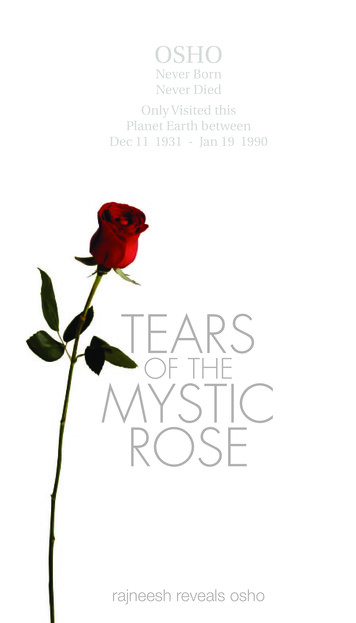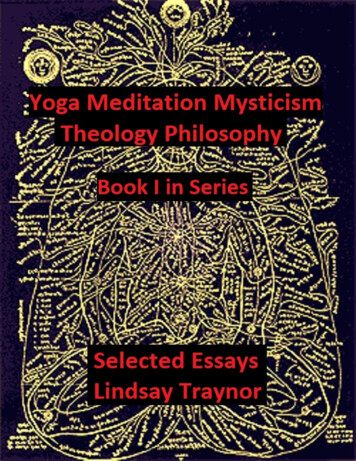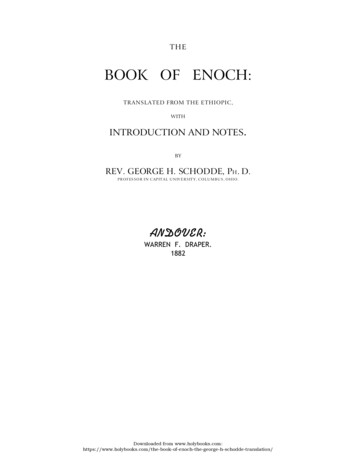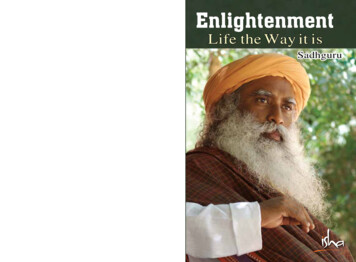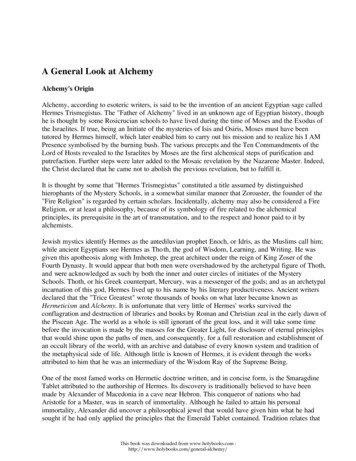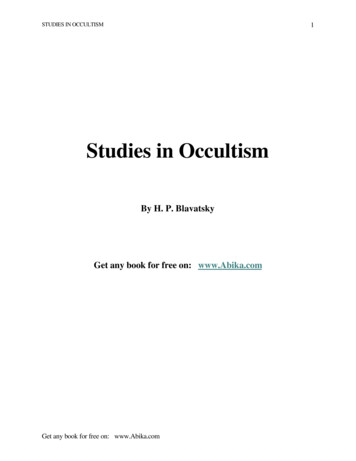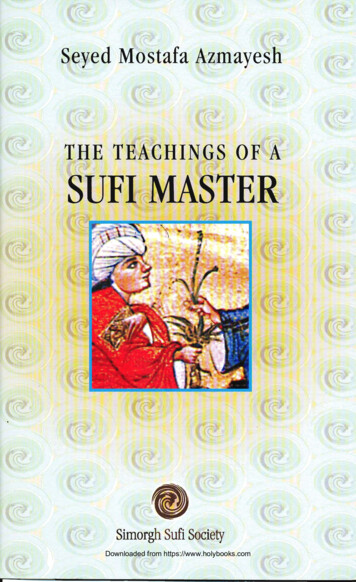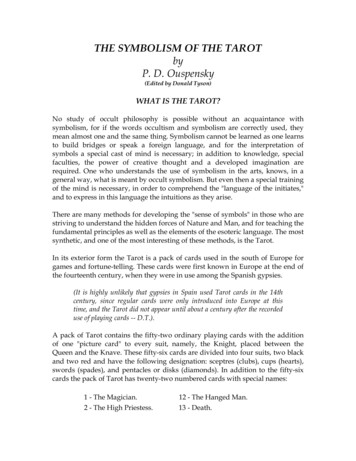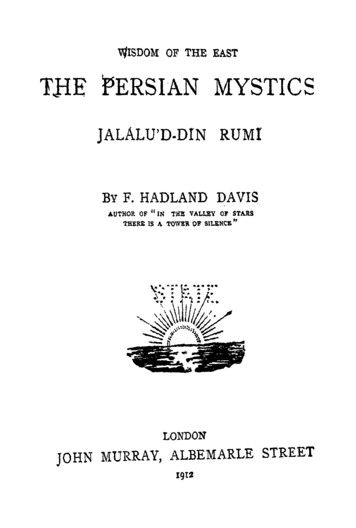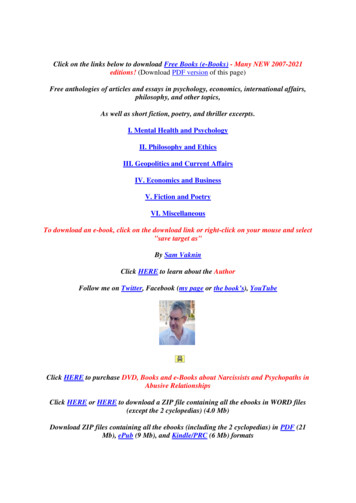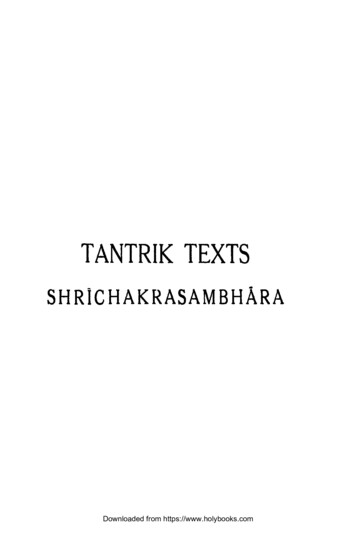
Transcription
TANTRIK TEXTSSHRICHAKRASAMBHARADownloaded from https://www.holybooks.com
TANTRIK TEXTS.UNDER GENERAL EDITORSHIP OF ARTHUR AVALON.Vol. I. TantrlbbidhAna with Blja-Nlghantu and MudrlNtgbantu. A Tantrik Dictionary, edited by T1lran!itha Vidy1lratna, vMh anIntroduction in English by Arthur Avalon. Re. 1-8.Vol. II. Shatcbakra Nlrlipana. A work on the six centres of thebody by Purnananda Svami, with Commentary of Shangkara. PAdukapanchaka. (" Five-fold footstool of the Guru"), with Commentary of K11.Jicharana and Notes from the Tik1l of Vishvan1ltha on the Second Patala of KaivalyaK1llik1l Tantra; with an Introduction in English by Arthur Avalon. Rs. 2.Vol. III. PrapanchasAra Tantra. Edited by Taranatha Vidyli.ratna,with an Introduction in English by Arthur Avalon. Rs. 3.Vol. IV. Kula.chudll.mani Nigama. Edited by Girisha Cha raVed1intatirtha, with an Introduction by Akshaya Kum1ira Maitra, K.I.H., B.L.Rs. 2.Vol. V. KuUlrnava. Tantra. Edited by Taral'liitha Vidyaratna, withIntroJuction in English by Arthur Avalon. (A full translation of this Tantra isin preparation.) Rs. 3.Vol. VI. KAllvilllsa. Tantra, Edited by Piirvati Charana Tarkatirtha,with English Introduction by Arthur Avalon. Rs. 2.In the Press,Vole. VIII & IXTantrarn.ja (Kldima.ta.). Edited by Mahamaho-padhy1iya Lakshmana Shastri Driivida.Vol. X. KAma.kallvil1 .sa. A Tantrik Prakarana of the KashmirSchool, by Piinyii.nanda, with Commentary by Anantanatha.Vol. XI. Advaltabhavopanlshad, K!Uyupanishad, TAropanlshad, Kaulopanlshad. With Introduction by Arthur Avalon.OTHER WORKS BY ARTHUR AVALON.Tantra of the Great Liberation.(MaMnlrvana Tantra.) ATranslation from ihe Sanskrit, with Introduction and Commentary by ArthurAvalon. Rs. 8.Hymns to the Goddess. From the Tantra and other Shastra and theStotra of Shangkaracharyya, with Introduction and Commentary, translatedfrom the Sanskrit, 1,y Arthur and Ellen Avalon. Rs. 3.Principles of Tantra. Part 1.-The Tantratattva of Shriyukta ShivaChandra Vidyarnava Bhattacharyya Mahodaya, edited with an Introductionand Commentary by Arthur Avalon. Rs. 8.Principles of Tantra, Part 11.-With an Introduction by ShriyuktaBarada Kanta Majumdar, edited by Arthur Avalon. Rs. 12."Wave of Bllss " (Anandalahari). A Translation and Commentaryby Arthur Avalon. Re. 1-8."Greatness of Shiva" (1!4ahlmnastava of Pushpadanta). ATranslation and Commentary by Arthur Avalon, together with Sanskrit Commentary of Jagannrltha Chakravartti. Re. 1-8.Studies 1D the Mantra Sbastra. (Re-prin,ing.)Shakt1 ancl Sh,kta. Second Edition. (Jn the Press.)To be had ofLUZAC & co., LONDON; THACKER, SPINK & co"., CALCUTTA ;GANESH & CO., MADRAS; TARAPOREWAl.A & SONS, BOMBAY.Printed by Thacker, Spink & Co., Calcutta.Downloaded from https://www.holybooks.com
T ANTRIK TEXTSUNDER GENERAL EDITORSHIPOFARTHUR AVALONVOL. VIISHRICHAKRASAMBHARA TANTRAA BUDDHIST TANTRAEDITED BYKAZI DAWA-SAMDUPLUZAC & CO., LONDONTHACKER, SPINK & CO., CALCUTTAr9x9Downloaded from https://www.holybooks.com
rRINTED BYTHACKER, SPINK & 00CALCUTTADownloaded from https://www.holybooks.com
.FOREWORD. I ·was !11Y intention in starting this Series of TantrikT ts ;to include therein specimens from all the varioussc ooJ of .Agama, Vaishnava, Shaiva, Shakta andBauadha. For, whatever may be the difference asregards doctrinal and ritual details, there are markedsimilarities in spirit, general outlook, and methodbetween all the Agamas; and though, as I have oftensaid, the use of the phrase " the Tantra " is vague andincorrect, an examination of the Tantras of the Agamasof differing schools do enable us to extract therefromcertain common features which, when found in any work,enables us to describe it as being of a " Tantrik "character. The inclusion therefore of Tantras of varyingschools in this Series will establish this point. So acoming volume will contain a Tantrik Prakarana of theKashmir School called Kamakalavilasa. The Buddhh.Demchog Tantra here printed is the first BuddhistTantra to be published, and the first to be translated intoany European tongue.As in the case of the Indian Tantra, the BuddhistTantra has suffered neglect. In both cases one of thereasons has been the great difficulties of the work.Nevertheless, as in the case of the Indian Tantra,a very imperfect knowledge and understanding of thesubject has not stood in the wa;,7 of adverse and absurdjudgments. Thus, when speaking of the doctrinal theoriesof the great saint and poet Milarepa, it has been said, .aDownloaded from https://www.holybooks.com
[ iv ]'.the italics being mine (" Tibet and the Tibetaf:ls ,.by the Rev. Graham Sandberg, 260): '' As is' invariablythe case in Buddhist philosophical statements, vt;:ere .weto quote here (as we do later) these enunciations,· eywould be found to contain no real recondite wisdom,nor even any scheme of metaphysics and moraUty whichcould be dignified with the title of an ethical system.They are, mostly, mere pretentious phrases which havelittle consistency, and the profundity is only apparentand will not bear analysis. There is nothing ennobling tothe individual, or calculated to make the world better ;or even, in the Buddhist sense, less steeped in misery,in the doctrines of sublime vacuity and indifference toall earthly claims with which Buddhism, whether Indianor Tibetan, occupies itself. It is essentially the religionof phraseological terms and onomato-poetical positions.Even the universal philanthropy preached becomesdegenerate when it would condescend to practical individual exercise." Though perhaps this is an extremestatement, many other Western authors expatiate on the"meaningless" " charlatanism" and "degeneracy" ofNorthern Buddhism. When will they learn, in this asin other cases, not to discredit common humanity bysupposing that any large body of men have devotedthemselves throughout the ages to "meaningless"doctrines and practices I If they are meaningless to them,it is because they do not know the meaning. And whatis yet known of the Buddhist Tantra ? Very littleindeed. Religious prepossessions will naturally assign tothe critic's own religion (if he have one) a superior worth;for if he did not believe it superior to all others, he wouldnot presumably follow it. Racial prejudice often grudgesto the Asiatic the possession of any real merit, much lessDownloaded from https://www.holybooks.com
[V]superiority over Western theories of life. Neverthelessthe true spirit of scholarship will endeavour to be just,and if any doctrine or practice is not understood, it isbetter and safer to admit this ignorance than to allegemeaningless and absurdity-a charge which often impliesnothing more than irritation in the face of what is notunderstood. We are, many of us, too disposed to hold thatwhat we cannot understand has no meaning at all. Thatis because we over:flatter both our abilities and knowledge. It is surely the acme of absurdity to deny thatNorthern Buddhism has any scheme of metaphysic, whenit has developed some of the most subtle and logicallywelded themes which the world has ever known ; or todeny that it has an ethical system, seeing that Buddhismas also Brahmanism have produced the most radicalanalysis of the basis of all morality and have advocatedevery form of it which any other religion has affirmed tobe of worth. It is a commonplace however, which isnevertheless to be remembered, that in all religionsthere is a mass-religion suitable to the less developedminds of the majority of the community and the religionof the highly educated, the spiritually developed, and thesages. Even present-day Christianity, which pridesitself on havmg no esoteric teaching, shows those differences which we might naturally expect when mindsdiffer in both capacity and knowledge. There is thusa high philosophic Tantricism and that of the crowdwith its cruder beliefs. Whilst ,the adherents of theformer are blamed for " their sublime vacuity andindifference to earthly claims," the majority are calledto book for making religion a means to secure materialgain-as if man all the world over did not seek andpray for earthly benefits. So whilst the mass believe inDownloaded from https://www.holybooks.com
[vi]the objectivity of the multitudinous Devatas, theinitiate is aware that they exist only in the mind, andby means of the mind, which gives them the life whichthey possess. But though their existence is that of themind, that is not to say that they are nothing. And sothe Brihadaranyaka Upanishad says that those whoadore the Devas, thinking that they are different fromthemselves, such men the Devas make their beast ofburden. In the philosophic presentment and its accompanying ritual, the idea of the Void (Shfmyata) dominates.After the Chela has gained a clear vision of the Devatasoccupying the different parts of the Mandala of worship,he arrives at a point in which the Devatas graduallymelt the one into the other, and are all absorbed in theprincipal Devata which occupies the centre of theMandah,, and this in its turn gradually effaces itself andis absorbed in the Bindu (Thigle) between the eyebrows{Ajna-chakra) where is the Point of Light which itselfdisappears in the Void. Similar principles govern theworship of the Indian Shri-chakra. Both are instancesof the Tantrik method by which the S1idhaka is made topractically realise that he is one with all that is, and thatall is at base Shunyata or Paramatma, as the case may be.It is not enough to theoretically affirm that identity,Proof must be given of it; and the only real proof anywhere is direct (Pratyaksha) experience. So to takeanother instance: the mass ot Buddhistic believers maythink that union with the Dakinis consists in gaining thefavour of female-spirits. Esoterically however the adeptprojects his creative will into the Matrix of the· MotherEnergies which are the Matris and Dakinis and thereengenders active forms and powers which are indeedhitnself as such, since all that is without is within.Downloaded from https://www.holybooks.com
[ vii ]And so also the Buddhas project the Bodhisattvas whocreate in their turn. But beside all this mysticism which,whether rightly founded or not (a matter with which I amnot concerned). is, as a system, philosophically profound,there are to be found amongst Buddhist and IndianTantrikas inferior practitioners given over to an evilmagic which is yet by no means always " charlatanism "as most Orientalists aver, and to abuses in connectionwith what in India is known as the Chakra ritual. Theignorant lay-folk in these and other countries envisagespiritual truths so grossly that they come to be calledsuperstition. All evil and ignorance is so much by itsnature on the surface and affords so apt a subject foradverse judgment that it is readily seized upon, and themore so that it is convenient material for religious polemic.Nevertheless I repeat that we must do credit both toour intelligence and sense of justice by endeavouringto understand any religion in its highest and truestaspect. The Tantras, whether Buddhist or Indian, containboth a profound doctrine and a wonderfully conceivedpraxis. And so it was said of Marpa, the founder of theKar-gyu-pa sect, that" his Dorje (Vajra) revelled in theprofoundest of Tantras."The translator of this work is a Sikkhimese, KaziDawa-samdup (zla-va-bsam-hgrub) who, when I first madehis acquaintance, was chief interpreter attached to the staffof H. E. Louchen Shatra, the Tibetan Plenipotentiary tothe Government of India. Befor that, he was Translatorand Interpreter to the Government of India in Bu:xa-Duarand Rajshahi, and (as he is now) the head of the Stateschool at Gangtok in Independent Sikkim. He was alsoattached to the political officer's staff on the visit of HisHoliness the Da,lai Lama to India. Kazi Dawa-samdup is aDownloaded from https://www.holybooks.com
[ viii ]Tibetan scholar, whose version of some portion of Milarepa'sHymns have been adopted by the Government of India asa text-book for the high proficiency examination in Tibetan.He has also got a good knowledge of English and someknowledge of Sanskrit which has been very useful inthe discussions we have had as to the rendering to begiven to particular passages or words. For it is to beremembered that the Tantrik doctrines were introducedinto Tibet from India, and many Tantras which are inTibetan w.ere formerly in Sanskrit. The Mantras in thetext translated are in Sanskrit, though Tibetan script isemployed. These Mantras are generally incorrectlywritten, and it is often difficult to state them correctly.I have not in general attempted to do so. I have kept tothe spelling and accents of the texts. As regards some ofthe longer and more important Mantras, I have suggesteda correct reading. As regards this, I acknowledge withthanks the assistance of Mahamahopadhyaya SatishChandra Vidyabhushana, Principal of the Sanskrit College,Calcutta, and himself a Tibetan scholar.I have not had more than one part of this Texttranslated for two main reasons. The first Part willgive the ordinary English reader an idea of the generalcharacter of the ritual work, which is sufficient for mypresent purposes. In the next place, the translator andmyself lost through their death the advantage of the verylearned assistance of the Guru of the former and of theEnche Geshe.The translator not being an initiate in this particularTantra was unwilling, for the present, to continue thetranslation of the other Parts without the assistance ofits learned votaries. Summaries have therefore beengiven of the Parts subsequent to the first which has beenDownloaded from https://www.holybooks.com
[ ix]fully translated. This will probably serve the purposeof the ordinary English reader. Tibetan scholars have;here the text to translate if they can. The translatorihas given full explanatory notes to the text, and has 1written a useful Introduction on the Vajrayana andMantrayana, to which this Demchog Tantra belongs, thevaluable manuscripts of which, with
former are blamed for " their sublime vacuity and indifference to earthly claims," the majority are called to book for making religion a means to secure material gain-as if man all the world over did not seek and pray for earthly benefits. So whilst the mass believe in Downloaded from https://www.holybooks.com
